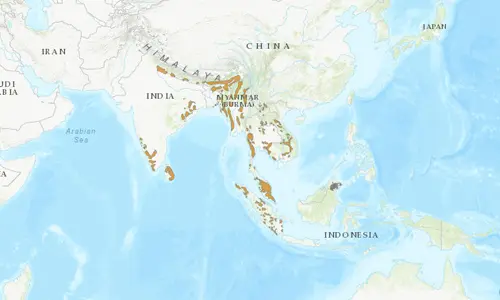Asian Elephant: hereâs the scoop
threats
Elephants require much larger areas of natural range than many other terrestrial mammals; therefore they are often the first species to suffer the consequences of habitat fragmentation and destruction. Elephants are also considered a pest and a danger in areas of agriculture and suffer from poaching and human conflict. There has been an overall population decline of at least 50% over the last three generations (or roughly ~75 years).
Committed to Conservation
The Buttonwood Park Zoo participates in the Association of Zoos and Aquariums Species Survival Plan (SSP) for Asian Elephants. The goal of the SSP is to cooperatively manage animal populations within AZA accredited zoos to ensure the sustainability of a healthy and genetically diverse population while enhancing the conservation of this species in the wild.
Buttonwood Park Zoo supports numerous Asian elephant field conservation projects, donating over $25,000 in the past several years to assist rehabilitated wild elephants, provide funding for advanced education for field veterinarians in Vietnam, and to protect habitat and reconnect the forest homes for endangered Asian elephants.
The Asian elephant is an AZA Saving Animals From Extinction (SAFE) Signature Species. AZA’s SAFE program focuses the collective expertise within AZA accredited zoos and aquariums and leverages their massive audiences to save species. Between 2011 and 2015 more than $8.1 million was directed towards Asian elephant conservation. 29 AZA accredited facilities, including Buttonwood Park Zoo, reported spending nearly $1.6 million specifically to protect and conserve Asian elephants.
Insider Info
Emily, a remarkable 60-year-old Asian elephant, has been inspiring generations for the past 56 years here at BPZOO! She weighs approximately 8,000 pounds and enjoys a daily diet consisting of around 75 pounds of hay, 10 pounds of grain, 10 pounds of produce, and 15 to 50 pounds of browse (such as maple and bamboo). Emily’s favorite treats include alfalfa cubes, dried fruit, watermelon, and sugar cane. She loves engaging in activities like drumming and painting When she is engaged with her enrichment, she expresses her joy with rumbling sounds or gentle trumpeting.
In Memory: Ruth 1958-2024
For 38 years, Ruth was a beloved member of the Greater New Bedford community and BPZOO family. She meant so much to our animal care team and she touched countless others with her gentle nature, immense strength, and obvious intelligence. She is a symbol of compassion and resilience for so many. She helped pioneer new treatments for elephants with pododermatitis, all while raising awareness about the conservation of Asian elephants and the importance of preserving their natural habitats.
We are aware that many want to donate to Asian elephant conservation in Ruthâs honor. Here are a few organizations who are working hard to help her endangered species.”
Species
Asian Elephant
Scientific name
Elephas maximus
Habitat
Grassland, tropical evergreen forest, semi-evergreen forest, moist deciduous forest, dry deciduous forest, and dry thorn forest, in addition to cultivated and secondary forests and scrublands
Diet
Herbivorous. They are generalists that browse and graze on a variety of plants, browse and grasses
Life Expectancy
50+ years, but this number varies greatly
Did you know?
Elephants are the largest living land animal. Compared to African elephants, Asian elephants are smaller, typically lack the iconic tusks, have smaller ears and only have one “finger” at the end of their trunk!

Range
Bangladesh, Bhutan, Cambodia, China, India, Indonesia, Laos, Malaysia, Myanmar, Nepal, Sri Lanka, Thailand, Vietnam
Conservation status
Endangered
High risk of extinction in the wild